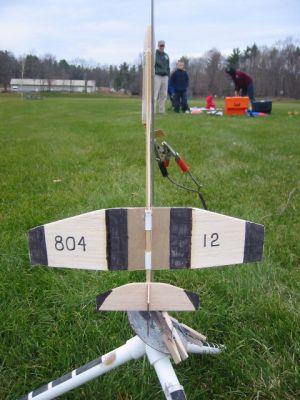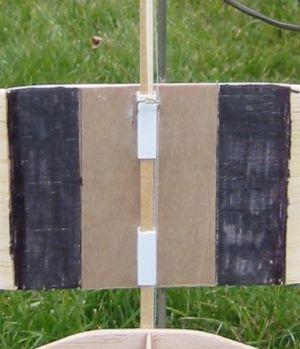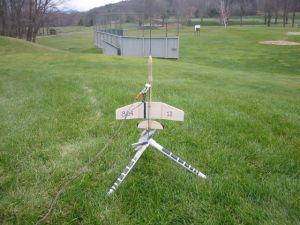Qualified Competition Rockets Easy Slide I 1/2
Qualified Competition Rockets - Easy Slide I 1/2
Contributed by Clive Davis
| Construction Rating: | starstarstarstar_borderstar_border |
| Flight Rating: | starstarstarstarstar_border |
| Overall Rating: | starstarstarstarstar_border |
| Manufacturer: | Qualified Competition Rockets  |

Brief:
Easy Slide I 1/2 (1/2A and A motors) is a slide wing rocket glider using a 13mm
engine mount.
Construction:
This kit, the Easy Slide I 1/2 (catalog no. 18), is a rocket glider using the
sliding wing concept for glide recovery. The kit comes in a clear plastic bag
with a header card. Parts include:
- balsa nose cone
- 13mm body tube
- balsa for wings, stabilizer, and rudder
- spruce for boom
- plywood for stab incidence and wing support
- hooks for strings and launch rod guides
- plastic sliding box pieces
- rubber bands, clay, thread
QCR kits are generally skill level 3 or higher. Having to cut fins and wings from balsa sheets is standard with QCR kits. Also, having to build delicate moving parts or mechanisms is another standard in the QCR kits.
I had previously completed the 1/4A version Bumble Bee of this Easy Slide I plan, so I had a good idea how to put the kit together. Most of the instructions for the Easy Slide I 1/2 are identical to the Bumble Bee plans.
I began by first cutting out the pre-marked balsa sheets for wings, rudder and stabilizer. I then sanded the recommended airfoil. After this, I cut the wing into three sections and recreated the dihedral. The problem with the plan is that in step 4, it does not indicate what the wing dihedral height should be, however, on another sheet included in the plans there are optional dihedral drawings with measurements.
 Next, I glued
the plywood support to the bottom of the wings. The plywood support is included
in the parts, but there is no indication in the plan how to use the part. I
then placed the plastic sliding boxes on the spruce boom, placed some CA on the
bottom of the boxes, and then glued the boxes on to the bottom of the plywood
support/wing unit. I did this to make sure the boxes were in line with each
other. I immediately removed the boom from the box/wing unit and allowed the
glue to dry. After this, I glued on one of the wire hooks to the front sliding
box. The purpose of this wire hook is to hold the rubber band.
Next, I glued
the plywood support to the bottom of the wings. The plywood support is included
in the parts, but there is no indication in the plan how to use the part. I
then placed the plastic sliding boxes on the spruce boom, placed some CA on the
bottom of the boxes, and then glued the boxes on to the bottom of the plywood
support/wing unit. I did this to make sure the boxes were in line with each
other. I immediately removed the boom from the box/wing unit and allowed the
glue to dry. After this, I glued on one of the wire hooks to the front sliding
box. The purpose of this wire hook is to hold the rubber band.
After gluing on the stabilizer and rudder, I test fit the wing unit to the boom. I had to sand down the boom quite a bit so that the wing unit could easily slide up and down the boom. Once the fit was right, I left the wing on the boom and then glued the standoff for the motor tube. After this had dried, I glued on the motor tube and nose cone. I covered the stand off and nose cone with epoxy, making sure the ejection ports received a good share of epoxy to protect the body tube from the ejection charges. I then added the wire hooks in their correct locations (one in the tail, one under the ejection ports, one in the front of the glider, and the wire launch "lugs".
That's it. All I had to do now was trim the model.
PROs: good quality parts.
CONs: instructions vague on some points, absent in content on other construction points.
Finishing:
Since this is a competition model, all I did was use a magic marker to create a
few black stripes on the model along with adding my NAR number.
Next, I added the rubber band, pulling the wings forward. I then placed an empty 13mm motor in the motor mount and began trimming the glider. Fortunately, the instructions come with some good tips for trimming the glider.
PROs: easy to finish since it is a competition model.
CONs: If you are looking for an easy glider to build for long durations, this may be your model but expect to spend a lot of time trimming your model.
Construction Rating: 3 out of 5

Flight:
I flew the R/G twice. Once on a 1/2A3-2T and once on a 1/2A3-4T. I was
launching with a bunch of kids and they wanted to see the glider work. Thus, I
elected to use a long delay motor, since I had run out of 1/2A3-2T motors, for
the second flight.
The first flight netted over 23 seconds. The second flight much less because the ejection charge burned the string way past apogee.
The 1/2A3-2T motor is perfect for this kit. I did not get great glide times and think that the wings might need to be sanded down even more to lighten the rocket.
PROs: Great flights on this R/G.
CONs: Takes a long time to tie back wings, put string through burn hole, tie off string, and add rubber band. Also, the motor has to be friction fit unless one elects to use a motor hook (most competitors do not use engine hooks to reduce overall weight).
Recovery:
PROs: A well engineered kit. I have not had any failed flights with this
design. The slide wing mechanism works quite well. Glide recovery is neat to
watch.
CONs: None.
Flight Rating: 4 out of 5
Summary:
This is a really interesting kit. I am really getting excited about R/G
technology. This kit certainly calls for a lot of time in observing the flights
and experimenting with the trimming and gliding of the Easy Slide I 1/2.
Overall Rating: 4 out of 5
 |
 |
Flights
 |
 |